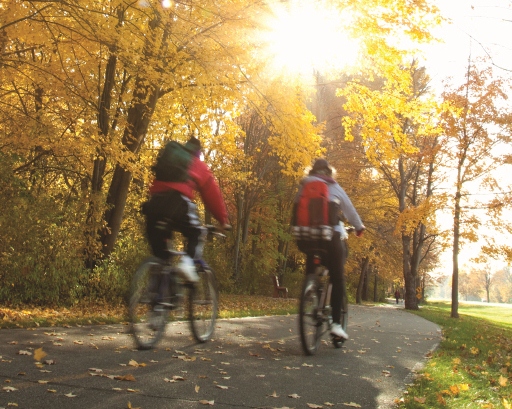
By Matt Doll, Minnesota Environmental Partnership – (@mattjdoll)
Two weeks ago, we reported on efforts to making Minnesota’s transportation sector – our number one source of carbon emissions – cleaner and healthier. In that issue, we focused on electrifying fossil-fueled vehicles. But an even more efficient part of the solution is reducing reliance on motor vehicles in general, and encouraging commuters to walk or bike to day-to-day destinations. These modes are inexpensive, promote public health, and have low maintenance costs, and importantly, contribute virtually no greenhouse gas emissions.
Minnesota has many favorable rankings for bicycling under its belt. The League of American Bicyclists ranked Minnesota the second-most bicycle-friendly state in the nation in 2017. A University of Minnesota study the same year found that the average worker in the Twin Cities can reach more than 60,000 jobs in an average bicycle trip of 30 minutes – that number increases to more than 200,000 jobs for those willing to bike for an hour. And the Twin Cities isn’t the only bikeable area: the Bicycle Alliance of Minnesota has identified more than two dozen Bicycle Friendly Communities spread across the state.
Pedestrian rankings are high as well. Walk Score, an online service that rates municipalities and neighborhoods by the ease of walking, rates Minneapolis and St. Paul well above average among the 141 cities that it rates in the United States, Canada, and Australia.
However, these ratings are relative. Overall, it’s estimated that only about 9% of all trips in the Twin Cities are by walking or bicycling – and even that number is well above the national average. It’s clear that obstacles persist, obstacles that dissuade many people who would otherwise be open to bicycle or pedestrian commuting from doing so.
Admittedly, bitter weather during the harsher winter months, such as January and February, is a strong deterrent during those periods. But factors within our control by policy and practice can make a big difference in empowering people to choose these clean modes of transportation.
Safety

Last year in Minnesota, 45 pedestrians and 7 bicyclists were killed by motorists and nonfatal accidents numbered in the thousands. (Aside: the author has previously been the victim of a car-bicycle collision but managed to avoid any serious injury.)
Seniors, people of color, and people living in low-income areas are especially at risk of being hit by a vehicle while walking.
The two most common factors in pedestrian collisions (tied at 20% of cases) were drivers failing to yield the right of way, and pedestrians darting or dashing across a roadway. In bicycle crashes, drivers failing to yield the right of way was the single largest factor – it was identified in 38% of cases.
But an overarching factor is that infrastructure is frequently unsafe for pedestrians and bicyclists. A lack of protected paths and sidewalks, infrequency of crosswalk signals, and dangerous intersections contribute to danger even for attentive pedestrians and bicyclists. This problem is especially acute in communities of color and areas of concentrated poverty
Fortunately, many communities are committed to changing the status quo, and investing in making streets and paths safer for clean transportation. Slowing traffic speeds on certain roads can also alleviate the danger of collisions. Ramping up these efforts is key to reducing our cities’ transportation emissions and making cities more environmentally just.
Distance
Though commute times vary, the longest bicycle commute that someone would likely take from a residential area of Minneapolis to its downtown is roughly 40-50 minutes, with a similar number within St. Paul. But within the seven-county Twin Cities Metro, only about a quarter of people live in either of those cities. Many more Minnesotans have to travel quite a bit further to reach job opportunities. Decades of transportation plan around single-occupant vehicle commuting has made it difficult to solve the problem of securing affordable housing, accessible jobs, and a manageable, clean commute.
Public transit is one part of the solution. Buses deployed in the Twin Cities, Duluth, Rochester, and other communities come equipped with bike racks so that commuters can travel part of their distance by bus, then ride their bicycle if additional distance needs to be covered. Light rail cars are similarly outfitted.
Another dimension to consider is land use and population density: ensuring that adequate, affordable housing is available within walking or bicycle distance of jobs and services is an important environmental consideration.
Cultural and economic
Many people see bicycling as unfeasible because of prevailing culture or inadequate facilities where they work. Fortunately, many Minnesota employers, including several MEP member organizations, provide bike storage, showers, subsidies, and other amenities to employees who ride to work. The League of American Bicyclists has a Bicycle Friendly Business program in which companies can apply to be recognized for being welcoming to bicycle use, helping to spread word of the benefits to both employees and employers.
There is no one solution that will increase the number of Minnesotans who bike and walk to their everyday destinations. But the overall effort, like so many other climate solutions, is a win-win, resulting in lowered emissions, healthier people, and safer streets.